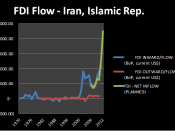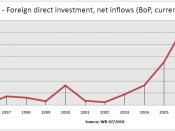Foreign investment is the acquisition by residents of a country of assets abroad. There are two types of foreign investment, known as foreign direct investment (FDI) and foreign indirect investment (FII). By definition, FDI is defined as the acquisition by residents of a country of real assets abroad which includes acquiring of land, constructing buildings, mines or machinery, or buying existing foreign businesses. On the other hand, FII or portfolio investment is the acquisition of financial assets abroad, for example represent equity investments, debt investments, intergovernmental loans and bonds.
There are significant differences between FDI and FII. Firstly, the objective of FDI is to gain managerial control of activities in the country of investment. Foreign owned enterprise would easily operate their activities in the host country and reduce other costs that might affect them if they perform their businesses from their home country. Contradictorily, FII objective is to gain short to medium term profits.
Therefore, foreign investors would invest in a portfolio which expected to give them better returns in the future and hence lead to profit acquisition.
The second difference is on the type of investors. Most of FDI is usually involve multinational corporations. These are the companies that operate, own and control production facilities in several foreign places. However, FII could be carried out by any individual or even speculators that would like to take an advantage of the foreign exchange.
Thirdly, is the difference in terms of asset liquidity. FDI assets are highly illiquid because most of the investments are in terms of real assets and they cannot be sold quickly and the price they will fetch is very uncertain. However, FII are in terms of financial assets and are easily turned into money rapidly at a fair and predictable price and consequently, this...


